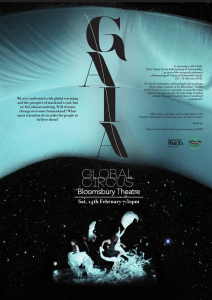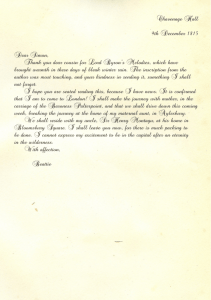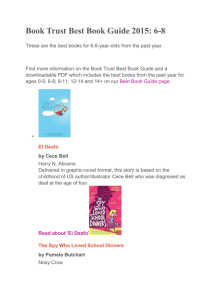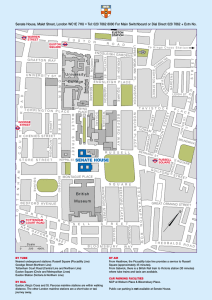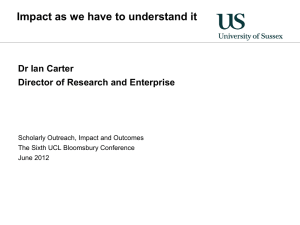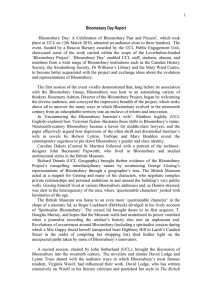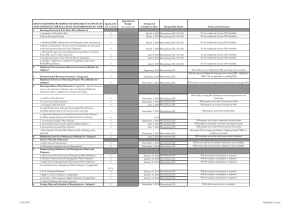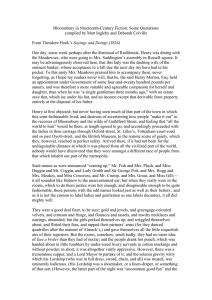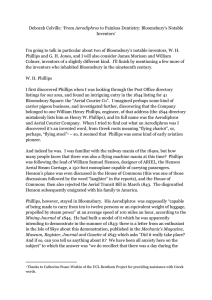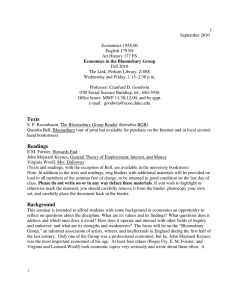B P By Carole Reeves
advertisement
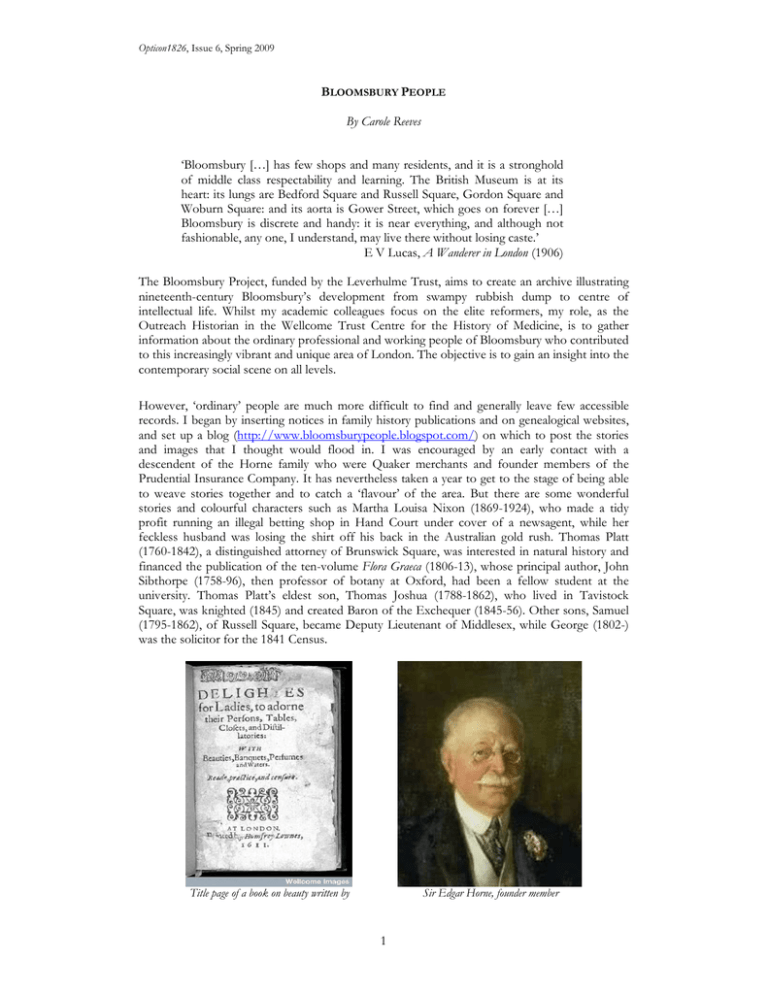
Opticon1826, Issue 6, Spring 2009 BLOOMSBURY PEOPLE By Carole Reeves ‘Bloomsbury […] has few shops and many residents, and it is a stronghold of middle class respectability and learning. The British Museum is at its heart: its lungs are Bedford Square and Russell Square, Gordon Square and Woburn Square: and its aorta is Gower Street, which goes on forever […] Bloomsbury is discrete and handy: it is near everything, and although not fashionable, any one, I understand, may live there without losing caste.’ E V Lucas, A Wanderer in London (1906) The Bloomsbury Project, funded by the Leverhulme Trust, aims to create an archive illustrating nineteenth-century Bloomsbury’s development from swampy rubbish dump to centre of intellectual life. Whilst my academic colleagues focus on the elite reformers, my role, as the Outreach Historian in the Wellcome Trust Centre for the History of Medicine, is to gather information about the ordinary professional and working people of Bloomsbury who contributed to this increasingly vibrant and unique area of London. The objective is to gain an insight into the contemporary social scene on all levels. However, ‘ordinary’ people are much more difficult to find and generally leave few accessible records. I began by inserting notices in family history publications and on genealogical websites, and set up a blog (http://www.bloomsburypeople.blogspot.com/) on which to post the stories and images that I thought would flood in. I was encouraged by an early contact with a descendent of the Horne family who were Quaker merchants and founder members of the Prudential Insurance Company. It has nevertheless taken a year to get to the stage of being able to weave stories together and to catch a ‘flavour’ of the area. But there are some wonderful stories and colourful characters such as Martha Louisa Nixon (1869-1924), who made a tidy profit running an illegal betting shop in Hand Court under cover of a newsagent, while her feckless husband was losing the shirt off his back in the Australian gold rush. Thomas Platt (1760-1842), a distinguished attorney of Brunswick Square, was interested in natural history and financed the publication of the ten-volume Flora Graeca (1806-13), whose principal author, John Sibthorpe (1758-96), then professor of botany at Oxford, had been a fellow student at the university. Thomas Platt’s eldest son, Thomas Joshua (1788-1862), who lived in Tavistock Square, was knighted (1845) and created Baron of the Exchequer (1845-56). Other sons, Samuel (1795-1862), of Russell Square, became Deputy Lieutenant of Middlesex, while George (1802-) was the solicitor for the 1841 Census. Title page of a book on beauty written by Sir Edgar Horne, founder member 1 Opticon1826, Issue 6, Spring 2009 Sir Hugh Platt (1611), ancestor of the legal Platts. Courtesy Wellcome Images, London. and first chairman of the Prudential Insurance Company. Courtesy Aldro School, Godalming. Bloomsbury seems to have early developed its cosmopolitan status and to have offered safe residence to non-conformists. The Foothead family of Gilbert Street (now Gilbert Place) and Southampton Row were Roman Catholics and lived in Bloomsbury in the eighteenth century. During the 1780s, John Foothead went off to Rome to train as a priest while his younger brother James, for reasons unknown, was sentenced at the Old Bailey to seven years of transportation. Upon his return (almost a miracle in itself), he became a schoolmaster alongside his other brother, Charles. Around 1822, a 'Mr Foothead' was recommended by Burke of Burke's Peerage as an excellent tutor in classics for the education of the sons of the US ambassador to England, at that time Richard Rush (1780-1859) of Pennsylvania, a son of Benjamin Rush, one of the signatories of the Declaration of Independence. Another interesting American connection is through the Horne family. Thomas Horne, whose great grandfather, Benjamin, had founded a successful coal merchants business at the start of the Industrial Revolution, lived in Gordon Square during the 1840s. Benjamin’s brother, Edward, had emigrated with a Quaker group to Philadelphia and was said to have been a friend and mentor to the young Benjamin Franklin (1709-90), another Founding Father of the United States. Franklin lived in London as a diplomat (1757-75) at 36 Craven Street, less than half a mile from Bloomsbury. His landlady's son-in-law, William Hewson (1739-74), ran an anatomy school from the house, and during its renovation in 1997, more than 3000 human and animal bones and other material artefacts were excavated. Tania Kasmaully, a PhD student and forensic archaeologist at the Wellcome Trust Centre for the History of Medicine is working on this extraordinary and unique material (http://www.ucl.ac.uk/histmed/people/research_students/#Kausmally,%20Tania). Benjamin Franklin invented the lightning rod. Courtesy Wellcome Images, London. Dr Thomas Hunt Courtesy Geoff Culshaw. Dr Thomas Hunt (c.1798-1879) of Bedford Square, whose family were Baptists, was trained at St Thomas's and at Guy's Hospital, London, and was admitted to the Royal College of Surgeons in 1820. He practised as a dermatologist and lectured on diseases of the skin at the College and was also consulting surgeon to the Western Dispensary for Diseases of the Skin, Great Portland Street. He served as Vice-President of the Medical Society of London (founded in 1773 and the oldest medical society in Britain) and was an active member of the Epidemiological Society (founded 1850). He was also Medical Officer of Health for the St Giles (Bloomsbury) District. Despite having thirteen children, the Hunts lived very comfortably at 26 Bedford Square, where the household included a cook, a housemaid and a page. Thomas was an exact contemporary of (and had trained with) two other eminent medical residents of Bedford Square, both of whom 2 Opticon1826, Issue 6, Spring 2009 lived at no 35 - Thomas Hodgkin (1798-1866), who first described Hodgkin's disease, and Thomas Wakley (1795-1862), founding editor of The Lancet. Although I have joined up the dots on these history trails, the stories themselves have been researched by descendents of the families who are, in effect, making a valuable contribution to the Bloomsbury Project. None of these individuals would have been ‘discovered’ without the dedicated efforts of family historians. © Dr Carole Reeves, 2009 Outreach Historian The Wellcome Trust Centre for the History of Medicine 3
